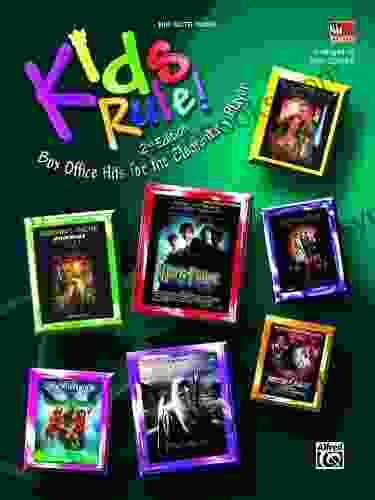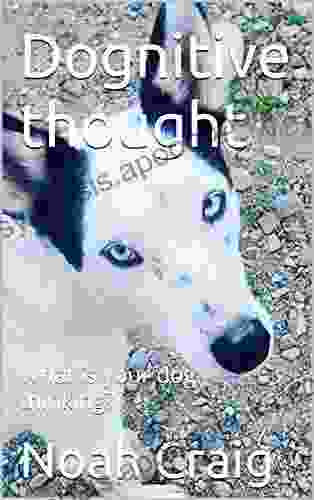Dognitive Thought: What Is Your Dog Thinking?

Have you ever wondered what goes on inside your dog's head? What thoughts and emotions shape their actions and behaviors? While dogs may not be able to talk to us in human language, there is a wealth of research and scientific evidence that provides fascinating insights into the cognitive abilities of our canine companions.
In his groundbreaking book, "Dognitive Thought: What Is Your Dog Thinking?", Dr. Stanley Coren, a renowned expert in dog behavior and cognition, delves into the intricate world of dognitive thought, exploring the remarkable mental capabilities of these beloved creatures.
4.7 out of 5
| Language | : | English |
| File size | : | 2373 KB |
| Text-to-Speech | : | Enabled |
| Screen Reader | : | Supported |
| Enhanced typesetting | : | Enabled |
| Print length | : | 18 pages |
| Lending | : | Enabled |
Decoding the Language of Dogs
Dogs communicate with us through a variety of vocalizations, body language, and facial expressions. By paying close attention to these signals, we can begin to understand what our dogs are trying to say.
- Barking: Dogs bark for a variety of reasons, such as to alert us to danger, express excitement, or seek attention.
- Whining: Whining is often associated with anxiety, distress, or pain.
- Howling: Howling is a long, sustained vocalization that is often used for long-distance communication or as a response to high-pitched sounds.
- Body Language: Dogs use their body language to convey a wide range of emotions and intentions. A wagging tail, for example, can indicate happiness or excitement, while a tucked tail may signal fear or submission.
- Facial Expressions: Dogs have a complex repertoire of facial expressions that can help us understand their emotional state. Raised eyebrows, for instance, may indicate surprise, while wrinkled noses can suggest disgust or fear.
By learning to decode these subtle signals, we can gain valuable insights into our dogs' thoughts and feelings, fostering a deeper and more meaningful connection with our furry friends.
The Power of Observation
One of the most important tools for understanding dognitive thought is simple observation. By observing our dogs in different situations and paying attention to their behavior, we can learn a great deal about how they think and perceive the world around them.
For example, if your dog becomes anxious when you leave the house, it may be helpful to gradually increase the amount of time you spend apart. This will allow your dog to adjust to your absence and reduce their anxiety levels.
Observation can also help us identify potential problems and seek professional assistance when necessary. If your dog suddenly starts displaying unusual behaviors, such as aggression, excessive barking, or destructive behavior, it is important to consult with a veterinarian or animal behaviorist to rule out any underlying medical or behavioral issues.
The Science of Dog Cognition
In recent years, there has been a growing body of scientific research that has shed light on the cognitive abilities of dogs. Here are some of the key findings:
- Problem-Solving: Dogs are capable of solving complex problems and finding creative ways to achieve their goals.
- Object Recognition: Dogs can recognize and distinguish between a wide range of objects, including their toys, food, and familiar people.
- Memory: Dogs have both short-term and long-term memory, and they can remember events, objects, and people for extended periods of time.
- Emotions: Dogs experience a wide range of emotions, including joy, sadness, fear, and anger. They are also able to empathize with the emotions of their owners and other humans.
- Communication: Dogs communicate with us through vocalizations, body language, and facial expressions. They are also able to understand some human language, including words and gestures.
These findings demonstrate that dogs have complex cognitive abilities that allow them to perceive the world around them, solve problems, and form meaningful bonds with humans.
Building a Stronger Bond with Your Dog
Understanding dognitive thought can help us build stronger and more fulfilling relationships with our canine companions. By learning to decode their signals, observe their behavior, and appreciate their cognitive abilities, we can create a more enriching and enjoyable life for both ourselves and our furry friends.
Here are some tips for fostering a stronger bond with your dog:
- Spend Quality Time Together: Spend plenty of time playing, grooming, and cuddling with your dog.
- Engage in Training: Training is an excellent way to build trust and communication between you and your dog.
- Provide Enrichment Activities: Challenge your dog's mind with puzzles, games, and other enrichment activities.
- Learn to Read Their Body Language: Pay attention to your dog's body language to understand their needs and emotions.
- Respect Their Individuality: Each dog is unique, so it is important to respect their individual personality and needs.
By embracing the fascinating world of dognitive thought, we can deepen our connection with our canine companions and create a lifelong bond based on mutual love, understanding, and respect.
For a comprehensive exploration of the cognitive abilities of dogs, I highly recommend reading Dr. Stanley Coren's book, "Dognitive Thought: What Is Your Dog Thinking?". This book provides a wealth of valuable insights and practical tips for anyone who wants to understand their dog on a deeper level.
4.7 out of 5
| Language | : | English |
| File size | : | 2373 KB |
| Text-to-Speech | : | Enabled |
| Screen Reader | : | Supported |
| Enhanced typesetting | : | Enabled |
| Print length | : | 18 pages |
| Lending | : | Enabled |
Do you want to contribute by writing guest posts on this blog?
Please contact us and send us a resume of previous articles that you have written.
 Book
Book Novel
Novel Page
Page Chapter
Chapter Text
Text Story
Story Genre
Genre Reader
Reader Library
Library Paperback
Paperback E-book
E-book Magazine
Magazine Newspaper
Newspaper Paragraph
Paragraph Sentence
Sentence Bookmark
Bookmark Shelf
Shelf Glossary
Glossary Bibliography
Bibliography Foreword
Foreword Preface
Preface Synopsis
Synopsis Annotation
Annotation Footnote
Footnote Manuscript
Manuscript Scroll
Scroll Codex
Codex Tome
Tome Bestseller
Bestseller Classics
Classics Library card
Library card Narrative
Narrative Biography
Biography Autobiography
Autobiography Memoir
Memoir Reference
Reference Encyclopedia
Encyclopedia Dallas Williams
Dallas Williams D Preston Davidson
D Preston Davidson Conrad Richter
Conrad Richter Malak Kalmoni
Malak Kalmoni Eric M Anderman
Eric M Anderman Mark Haber
Mark Haber Corey Yoder
Corey Yoder David Barrow
David Barrow David P Currie
David P Currie Dan Chiasson
Dan Chiasson Clive Mcclelland
Clive Mcclelland D J Moores
D J Moores Tracy Burton
Tracy Burton Colleen Kelley
Colleen Kelley Walter Jon Williams
Walter Jon Williams Connie Johnston
Connie Johnston Harriet Hyman Alonso
Harriet Hyman Alonso Cynthia Hanevy
Cynthia Hanevy Colin V Murray Wallace
Colin V Murray Wallace Costel Puscoiu
Costel Puscoiu
Light bulbAdvertise smarter! Our strategic ad space ensures maximum exposure. Reserve your spot today!

 Alexander BlairUnlock Your Drumming Potential: Embark on a 30-Day Transformative Journey...
Alexander BlairUnlock Your Drumming Potential: Embark on a 30-Day Transformative Journey...
 Roberto BolañoPenitent Bequin: A Gripping Journey into the Heart of Warhammer 40,000's...
Roberto BolañoPenitent Bequin: A Gripping Journey into the Heart of Warhammer 40,000's... Edgar CoxFollow ·17.2k
Edgar CoxFollow ·17.2k Peter CarterFollow ·4.1k
Peter CarterFollow ·4.1k Yukio MishimaFollow ·4.8k
Yukio MishimaFollow ·4.8k Gilbert CoxFollow ·15.9k
Gilbert CoxFollow ·15.9k Vernon BlairFollow ·7.2k
Vernon BlairFollow ·7.2k Charles BukowskiFollow ·3.4k
Charles BukowskiFollow ·3.4k Gene SimmonsFollow ·11k
Gene SimmonsFollow ·11k Gene PowellFollow ·13k
Gene PowellFollow ·13k

 Cooper Bell
Cooper BellKids Rule Box Office Hits for the Elementary Player
Empowering Young Performers:...

 Gabriel Blair
Gabriel BlairUnraveling the Enigma: Political Alienation and Its...
In the labyrinthine tapestry of human...

 Anthony Burgess
Anthony BurgessBe a Great Singer: Unleash Your Musical Talent with...
Do you dream of singing with...

 Heath Powell
Heath PowellDive into a Musical Masterpiece: "10 for 10 Sheet Music...
An Enchanting Journey Through Broadway...

 Guy Powell
Guy PowellUniversal Rights, Systemic Violations, and Cultural...
The notion of universal human rights is a...
4.7 out of 5
| Language | : | English |
| File size | : | 2373 KB |
| Text-to-Speech | : | Enabled |
| Screen Reader | : | Supported |
| Enhanced typesetting | : | Enabled |
| Print length | : | 18 pages |
| Lending | : | Enabled |









